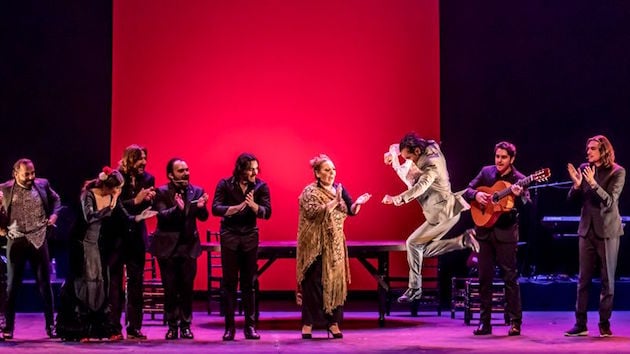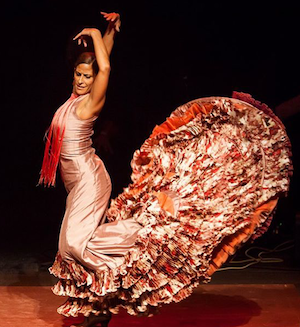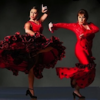
The Spanish term for a heightened state of emotion and authenticity, “duende,” roughly translates to a single word, “soul.” It’s also the elusive ingredient at the heart of flamenco, the centuries-old art form whose Andalusian origins, while not completely known, are an exotic blend of Jewish, Arab, and Roma (also known as Gypsy) cultures. Commonly thought of as an art of suffering — and punctuated by fiery footwork, rhythmic hand clapping, and raspy-throated singing and guitar playing that can veer from sensuous to scorching — flamenco, when performed by true artists, not only has the power to exist in a profound and mystical place, but can be a transformational experience for an audience, as well.
Happily, amid the urban sprawl that is Southern California, there also happens to be a rather tight-knit community of flamencans that stretches from Los Angeles down through Orange County and into San Diego, with upcoming performances including the Melissa Cruz-directed “Forever Flamenco — Evocar” (L.A.’s Fountain Theatre, October 27); Lakshmi Basile (San Diego’s Café 21, the Gaslamp location, November 2); the Spanish superstar Farruquito (Segerstrom Center for the Arts, November 6; the Soraya in Northridge, November 9); and Ethan (Margolis) Sultry and friends (Fountain Theatre, November 24).

That said, the indisputable Godmother of the L.A. flamenco scene is Deborah Culver, who cofounded the 78-seat Fountain Theatre in 1990 with Steven Sachs, and has been presenting flamenco concerts under the banner, “Forever Flamenco,” ever since. Dubbed “the earth and fire of first-class flamenco” by the Los Angeles Times, the series has been weekly, biweekly, or monthly, with Culver estimating that they’ve produced in excess of 500 unique performances over the years.
Culver said she was drawn to the dance for a number of reasons, first and foremost, that it’s a “great art. It’s compelling, it’s mind-blowing, it’s gorgeous, and we have some very good practitioners here [in L.A.]. I danced it, too, of course, but really, I respect the pros.
“Throughout my time producing Forever Flamenco,” added Culver, “I have seen the community grow, mature, and exceed even my wildest expectations, and there are many dancers who are really pulling it off, who are really in tune with flamenco.”
The Fountain Theatre has also produced numerous flamenco concerts in conjunction with the Ford Amphitheatre, a bucolic, 1200-seat venue across the street from its much larger counterpart, the Hollywood Bowl. Olga Garay-English, executive director of the Ford Theatres since 2016, recently presented Olga Pericet, winner of Spain’s National Dance award in 2018.

“The Fountain Theatre really needs to be praised for being a stalwart with not a huge financial undergirding — I think that they really deserve a lot of credit,” noted Garay-English, who added that under her Ford tenure, they have co-sponsored three concerts with the Fountain, including Pericet’s.
“I thought that flamenco really deserved a larger stage in the greater L.A. area,” she added, “so the first season I booked it in 2017, we actually commissioned a flamenco floor, which is more percussive. I also think that flamenco is an extraordinary art form that has really deep roots and yet it has become an international language, so to speak. You really see people taking up the form in very diverse cultures because it speaks to people.”
Garay-English agreed with Culver that the L.A. flamenco community is thriving and growing. “It’s a self-fulfilling prophecy — the more excellent flamenco that is available, the more people are interested in seeing the work. People are really thirsty for this caliber of flamenco.”
One performer who has been a fixture of the Fountain’s flamenco series is Los Angeles-based Briseyda Zárate. Born in Delano, California, and brought up by Mexican immigrants, she’s performed at the space for a decade and a half, either dancing with others or directing concerts at the venue with her troupe, Briseyda Zárate Ensemble.

In addition to beginning her own series, Noche de Tablao, last January at L.A.’s Bootleg Theater, 44-year old Zárate, a flamencan with a feline presence and feet of fire, has also danced with L.A. Opera in productions that include The Barber of Seville and in last season’s zarzuela hit, El Gato Montés, as well as having choreographed for the company in operas such as Carmen. The dancer, who lives and works several months of the year in the cradle of flamenco, Sevilla, Spain, is nevertheless, wholeheartedly committed to L.A.’s flamenco community.
“It’s an art form that requires, obviously, community,” explained Zárate. “It also requires people who perform, audiences who go see the performers, students who want to learn, teachers who want to teach and not just steps, but the culture itself, through a way of life, a country, a specific part of Spain, though it’s all over the world. It’s about connecting at the very core of the art form — connecting in the moment to the singer, the guitarist, to yourself — and creating the magic that you give to the audience.

“Flamenco is also about the audience feeling something,” she continued. “Yes, flamenco can get really difficult technically, but at its core, it’s a very simple human thing, because it comes from such a deep historical place and a deep emotional place and the music, the dance, the song transmits that place and the artist, the “bailaora” — dancer — has to be able to transmit that. Not every artist does that. People who do it like a machine and depend solely on technique, in flamenco that will never fly. That will never suffice.”
To Zárate, duende is the spirit the dancer generates and is something akin to a ritual. “You’re creating it and it’s very special and not something that can be done by anybody. It takes obviously a lot of study, and technique is the gatekeeper to how you reach that sublime place. However, it’s just the gatekeeper — there are no ifs, ands, or buts about it in flamenco. You cannot base it solely on your technique or virtuosity. Maybe you can get away with that in other art forms, but not in flamenco.”
Someone known for possessing duende in spades is Farruquito, heir to one of the world’s most acclaimed Roma flamenco dynasties. Born in Sevilla in 1982 as Juan Manuel Fernández Montoya, Farruquito has been described by The New York Times’ Alastair Macaulay as “one of today’s superlative dance artists.” Carrying on the tradition of his grandfather, “El Farruco,” the electrifying performer first made an appearance on Broadway at age 5, and is bringing a pair of shows, “Farruquito Flamenco,” to the Southland.
No stranger to drama, Farruquito, a master of line, quicksilver footwork, and authoritative presence, was involved in a fatal hit-and-run accident, eventually serving three years in a Spanish prison for the crime. Released in 2010, Farruquito came roaring back, continuing his life’s mission to share the purest form of flamenco on stages around the world.

As to the debate of flamenco being more a matter of nature or nurture, of bloodlines or experience, Farruquito wrote in an email that it is “a little of each. Theory without practice does not achieve much. And if we are looking at it as an art form, I think you have to go much deeper into that world. If you are lucky enough to be born in a family that can give you that experience in exposure, you have to work even harder to make something out of what you are given.”
Farruquito also shared his thoughts regarding duende, writing that it “means being accompanied by a certain magic that allows one to transmit something special, intimate, and ever-fleeting while performing. But for that duende to grace us with its presence, we must lure it in with passion, dedication, respect, humility, and everything else that it rightfully deserves.”

Indeed, high-quality flamenco, whether strikingly presentational à la Farruquito or decidedly internal, thrives on immediacy and texture. It also requires top-notch musicians. With its distinct rhythms and outside influences also coming from Africa and the Middle East, there is a timelessness that exists at the heart of this music. Cleveland-born guitarist/composer/producer Ethan Margolis, 41, known as Ethan Sultry (Sir Sultry is his production company), moved to Spain to study the art of Roma flamenco guitar at 21, eventually moving to Los Angeles in 2010.
While in Spain, Sultry and dancer Cihtli Ocampo (now his wife), cofounded the erstwhile Arte y Pureza Flamenco Company (Art and Purity), an acclaimed troupe that toured Europe and the States for a number of years. Blending American and Spanish roots music into a jazz/flamenco hybrid, Sultry has created a style bursting with complex flamenco rhythms that stem from India — with some of the melodies having an Arabic character — while the dance form, he pointed out, is an expressive, improvisational one that was first shared by Roma families in their homes.
“People don’t realize that dance is not always at the root,” explained Sultry, “because in the Gypsy household, the flamenco dance form before it got on stage, was in someone’s house, at a party, around a campfire. It was very short, about 40 seconds long, then it was over. It was about the singing and the rhythm.

“It transformed into what we see now as 10, 15, or 20 minutes of dance that evolved to be put on a stage and sell tickets,” added Sultry. “I try to feature the dance, because it’s incredible, but there’s so many dance-heavy productions. Last year we presented shows that featured songs from Gypsy inheritors and none of them were commercial artists. They spent 400 years developing this stuff and no one knows who they are. I’m trying to help people understand that flamenco is like a work-song culture — they’re singing their sorrows out and it’s not all about fast footwork.”
Which isn’t to say that Sultry is not a fan of the dance. On the contrary, his November concert at the Fountain, “Sonikete Blues: Woodshedding,” will feature dancer Ocampo, vocalist Emi Secrest, cajón (box drum) player Ramón Porrina, as well as his Ethan Sultry Group, including Lee Ritenour's upright bassist Ben Shepherd, and keyboardist Mitch Forman, who played with Gerry Mulligan and Stan Getz, to name a few.
“The Fountain is great for flamenco,” said Sultry, “and it’s because of people like Deborah. Other than the Fountain being an intimate venue, it’s the people allowing and pushing for flamenco to happen. They lose money but keep going. They allow artists to come in, do their thing and leave. I can’t imagine that the Fountain has financially benefited much from flamenco because it’s a labor of love. And it’s not,” adds the musician,” like every city has a Fountain Theatre.”
Sultry, who has a rather astonishing YouTube video that features him playing Sondheim’s “Send in the Clowns,” flamenco style, with his body-painted wife slinking around the stage, her arms raised with filigreed fingers slicing the air, has his own idea — no surprise — of what he deems duende.
“What I believe to be spirit — duende — is that [Spanish playwright Federico García] Lorca, who was a Gypsy-rights activist, put it out there as a term and ever since it’s been used all the time. It’s that sense of arriving at a real connection with the art form with your spirit. When he used the word,” added Sultry, “he was living within Gypsy circles, and he wasn’t just talking about a dancer. He was writing about their beauty, their sorrows, that’s where it came from. I believe he lived it and felt it, and once you know that, it’s hard to buy it in another setting.
“And while all art forms have a version of duende,” Sultry continued, “it’s the term within flamenco about arriving at this blissful place of spiritual expression that you can only get to if the elements of the form are true.”

Expressing her true self through haughty glances, an arched back and thrilling turns, California-born Lakshmi “La Chimi” Basile, 37, built her career in Sevilla, and currently lives in San Diego. Over the years she has performed throughout Europe and, at one point, had a company, Luna Flamenco Dance Company. A regular performer at the Fountain for years — having directed shows there, as well — Basile also danced on a weekly basis at the Cosmopolitan Hotel and Restaurant in San Diego’s Old Town district in 2017.
Now working on a project-to-project basis, Basile, who was born to an Argentinean/Paraguayan mother and an American father with Czech roots, also teaches flamenco and runs her own show at San Diego’s Café 21. While patrons might be eating and drinking during her performances, Basile said she’s had no problem with that.
“It requires a lot of stamina, but I present my show in a way that makes them pay attention. It just depends on how you attack it — and you can be mindful. That show ended up turning into a mini-showcase and I had regulars come to see me, so I was happy with how that turned out.”
But did Basile have flashes of duende during any of those performances? The dancer explained: “Duende, I believe is something you’re born with or you can stumble upon it at any given moment. It’s not something you work on like a step — duende doesn’t work that way. It either comes or doesn’t come, you can’t control it. Some people have duende moments a lot because they can transmit with a lot more ease than others.
“Even the people that have duende moments,” added Basile, “they can’t have it whenever they want. It’s more of a thing that comes, although I do believe some are born with it. There are also excellent performers who don’t have that magical moment. It’s almost like a spiritual thing — you have to channel energy in a different way than just being mental about the steps.”
Correction: The bassist Ben Shepherd mentioned in this story is not the Ben Shepherd of Soundgarden fame, as was originally published.





